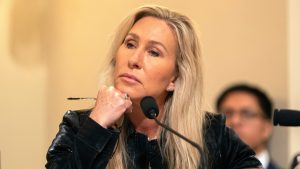Crisis of masculinity: Why young men are struggling to define manhood

This is part one of a series on the crisis of masculinity among young men. The series will cover the increasing number of young men feeling lost in society, the lack of strong male role models in modern media and what happens when the search for help takes you down an unexpected rabbit hole.
Will Adolphy was just a boy when he had to confront what it means to be a man in today’s society.
His parents divorced, and he had a medical issue that required 19 surgeries by the time he was 12. Complicating his life, he was a sensitive kid, one who didn’t always live up to what others thought he should be.
“If I go back to when I was 9 years old, I just remember having this real sensitive, almost innocent, tender-like energy,” Adolphy told Straight Arrow News. “So, at school, I definitely fell into ‘I’m not fitting into the box here,’ because the parts of me that were sensitive were getting judged. So, I became an easy target, right?
“By the time I got into my teens, I started to do my best to adhere to what I would call the man box,” he said, “this rigid set of rules that I unknowingly was trying to follow in order to be a real man.”
From pop culture to politics, society tries to dictate what it means to be a man. But to a growing number of young people like Adolphy, the definition of masculinity remains murky.
What is masculinity?
A survey by the National Research Group found that 43% of young men don’t know what it means to be a man today.
What men see as masculine may depend on their age. A 2023 YouGov poll found that a majority of older men are more likely than their younger counterparts to perceive themselves as completely masculine. Among male respondents aged 65 and older, half described themselves as masculine. However, among men between 18 and 29, the youngest cohort in the study, just 30% gave the same answer.
Matt Englar-Carlson, a mental health researcher and professor of counseling at Cal State Fullerton, says masculinity isn’t necessarily a binary.
“The reality is that for a very long time we just used the term ‘masculinity,’” Englar-Carlson told SAN. “And I think the problem with masculinity is that –– at that term with a ‘Y’ –– is that it seems to denote that there’s like one form of masculinity, when the reality is that there’s multiple forms of masculinity, meaning that masculinity is a variable, but it’s also influenced by other elements of identity.
“I’m a white, educated male primarily grown up in the Midwest. So my whiteness, Midwestern-ness, probably middle to upper class, and being educated influences my version of masculinity, as opposed to, let’s say, a colleague of mine who might be an undocumented immigrant from Mexico who was a first generation college student.”
Adolphy –– who now runs M-Path, an organization based in the United Kingdom that presents talks on masculinity and mental health –– turned to some of the darker traits associated with masculinity as he tried to better fit in with his peers.
“I started to bully other people and I started to be violent towards others,” he said. “I started to say racist and sexist jokes at times, and I got caught up in all that culture at school.”
Adolphy’s home life became dysfunctional during that period.
“I lived in like dad’s old office, in the end of a garden, and that became my like gaming den, where I would play ‘Call of Duty,’ masturbate, smoke weed, and I isolated,” he said. “I remember one time going to a birthday with my family. And I looked my brother in the eyes, and it was one of the most trippy experiences of my life, because I realized I hadn’t looked my brother in the eyes in years, and so part of my brain was telling me that’s my brother, and the other part of me was looking at a stranger.
“And in these photos at this time in my life, I can actually see bravado. I can see a real change, a mask, and that continued right into my kind of early 20s as I grew up.”
Shifting gender landscape
There wasn’t one specific moment when Adolphy realized he had fallen into the rabbit hole of “man-o-sphere” influencers.
“I remember having some experiences where I got told, ‘Men have it so much easier than women, you have male privilege,’” he said. Around the time the MeToo movement took off, he said, a friend went to a party dressed as toxic masculinity. Another time, the singer of a band announced, “Men to the back, men to the back.”
Like many in his age group, he became resentful of feminism. A King’s College London/Ipsos poll from March 2025 found that 56% of Millennial men and 57% of Gen Z men said “promoting women’s equality has gone so far that we are discriminating against men.” Meanwhile, 57% of Millennial men and 60% of Gen Z men agreed with the concept that men are expected to do a lot to support equality.
“I think the way I see that polarity is on the wounded men’s movement,” Adolphy said. “It’s, ‘Oh, the progress of feminism is a threat to men, and the world is rigged against men.’ And there’s a lot of that, and this kind of righteousness, or this resentment, gets projected onto the other side.”
“The gender landscape has been shifting for a while now,” he added. “For example, women are now more than ever in the workforce. Over in the U.K., approximately 34% of U.K. households have a female breadwinner, and personally, if I was going to give my opinion on it, I think it’s fantastic.”
The increased number of women in the workforce has caused a range of emotions among men, said Englar-Carlson, the Cal State researcher.
“[Some men think,] ‘Well, that’s really horrible for men,’” he said. “‘They had to give up something.’ And other men look at that and think, ‘What a great opportunity. Because prior to that, I felt like I couldn’t be a present father, or I had to put work over family. And now maybe I can actually be more of a caregiver and be proud of it.’”
Parents –– and biology –– may be contributing to confusion over masculinity. The National Research Group survey found that 48% of parents of young boys say they don’t know how to talk with their sons about masculinity. Furthermore, as Englar-Carlson points out, research indicates that young men’s brains continue to develop well into their 20s.
‘Toxic’ –– or ‘toxin’ –– masculinity
“Toxic masculinity” has been a mainstay in conversation in the social media age and post-MeToo era, as what is considered toxic behavior becomes less acceptable in society. The Pew Research Center found that 75% of respondents said it’s unacceptable for men to join in when other men are talking about women in a sexual way; 69% said it was unacceptable for men to have too many different sexual partners rather than committing to a single relationship; 63% said it was a negative for a man to drink a lot of alcohol when out with friends; and 62% said it was not acceptable for a man to throw a punch if provoked.
Englar-Carlson says he prefers the term “toxin masculinity” over “toxic masculinity.”
“The toxin thing ends up being this pill that men swallow,” he said. “That’s why I use it that way. And for a lot of men it’s a pill that later they realize they swallowed and kind of think, ‘Wow, I didn’t think that was going to work out, that that didn’t turn out the way that I thought it was going to turn out.’”
He adds that masculinity’s negative manifestation, in many ways, has to do with the power dynamics of society.
“The same things that encourage men to kind of show power over others and to aspire to these really dominant norms are the same things that are probably the reasons why men die five to six years earlier in Western societies than women, which is in order to prove our masculinity,” he said. “We don’t go to the doctor, we don’t take sick days, we don’t wear helmets or seat belts or sunscreen or all these kinds of things –– the health behaviors we don’t do –– and that kills us.”
Finding help
According to data from the National Institute of Mental Health, in 2022, nearly 20% of men identified as having some form of mental illness, including anxiety and depression. But only about 42% of those men received treatment, compared to nearly 57% of women.
“It’s just very difficult in a culture where I might feel like I’m judged to actually express or explore these other parts of me and who I am,” Adolphy said. “I didn’t know this, but I felt almost like I was addicted to my anxiety and shame, like I felt a magnetic pull towards anxiety and shame, because it felt safe there. It felt familiar.
“So whenever I was in serenity or calmness, there was a part of me that didn’t feel safe there, because it was like, well, I need to be prepared. And when a person is in that state of lostness, in the U.K., where I was, there’s not much that is offered outside of, go to the [general practitioner], get on medication, maybe see a therapist. So I did those things, and it kind of helped me to cope. But it wasn’t enough, and so I went online.”
When Adolphy entered the online space, he found a world filled with online influencers and hopes of finding help.
In part 2 of the series on the crisis of masculinity, Straight Arrow News digs into masculinity in pop culture and how young men like Will Adolphy feel about the role models presented in media.





